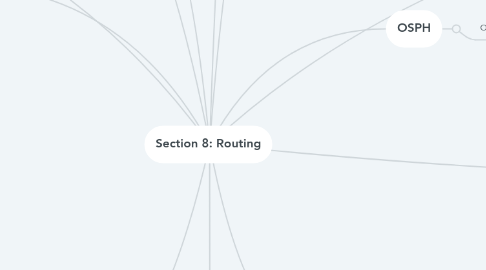
1. Introduction Routes
1.1. * Router is a box that designed to interconnect network IDs
1.1.1. * 1-Switches filtered based on MAC Address
1.1.2. * 2-Routers filtered based on IP addresses
1.1.3. * 3- Routers have at least two connection
1.1.4. 4- routers doesn’t care where bucket come from only where it’s going
1.2. * Routers can connect with other ethernet connections or DSL and all kinds of different connections
1.3. * metric : is a relative value that gives your router an idea if it has more than one choice to do something wich way does it go
1.4. * metric : is a relative value that gives your router an idea if it has more than one choice to do something wich way does it go
1.5. * Each router has a rotating table built in and it’s have at least 4 columns ( Address-Subnet-Gateway-Interface)
1.6. New Topic
2. understanding port
2.1. * Every TCP bucket has two port numbers
2.1.1. 1- Port Numbers 0-1023 ara called Well Known Port
2.1.2. * 2 Your computer generated the ephemeral part 1024-65,353
3. implementing NAT
3.1. * every home router in existence has net turned on by default
3.2. * Bigger router doesn't have turned on by default
3.3. * NAT on a SOHO router can be disabled from the router's confiquration page
4. port Forwarding
4.1. * Port forwarding: help you to have access to one or more devices on the inside of our added Network
4.2. * Any outside queries based on a specific port number are forwarded to a specific computer.
4.3. * It is common to use a non-standard port number for security.
5. Tour of a SOHO Router :
5.1. * there is a important information coming with Router documentation (Default IP address for Router 192 160 0 1 ) + default username + default password)
5.2. * Change your local IP address in your Router IP to protect it from hacking
5.3. * All home routers are DHCP serve
5.4. * Hard reset : The process of changing the device settings to the factory settings - we do it when the device does not work correctly
5.5. * 30 30 30 kind of hard reset
6. * Dynamic Routing Protocols broken up into two groups :
6.1. 1-interior gateway protocols IGP
6.2. 2- exterior gateway protocols EGP *only BGP “ is the protocol that runs between autonomous systems
7. RIP
7.1. RIP( routing Information Protocol )
7.1.1. 1- it is IGP
7.1.2. 2 - it is distance vector protocol
7.1.3. 3- One of the oldest dynamic Routing Protocols
7.1.4. 4-it’s used usually only in small networks
7.2. * RIP 1 used only classful networks
7.3. * RIP 2 maximum hop count is 15
8. OSPH
8.1. OSPH ( Open shortest path first )
8.1.1. 1-it’s IGP
8.1.2. 2- it is dynamic Routing protocols
8.1.3. 3-uses link states protocols
8.1.4. 4-Has area ID : make communication between all the routers in the area ID decide who The designated router and who The backup designated router
8.1.5. 5- converges very quickly
9. network address translation
9.1. * NAT :Network address translation
9.2. Versions of NAT
9.2.1. SNAT ( static NAT) : *changes the private IP address of the source host to public IP address. *used by internal users to access the Internet.
9.2.2. DNAT( dynamic NAT): * has a limited pool of Internet addresses to give to a number of internal devices *Two IP address is built in the router and if one devices want to get out router will give it one ip address and he can connect with Internet
10. DMZ, Port Range Forwarding, and Port Triggering :
10.1. * port Range Forwarding : Port range forwarding is similar to port forwarding but is used to forward an entire range of ports.
10.2. * DMZ: It is a neutral network, so it is not completely protected and secured, as is the internal network. Nor is it explicitly exposed as the Internet is. The DMZ solution is used when needed to enable users in the external network to access some local services such as Web Server
10.3. * Port triggering is a configuration option on a NAT-enabled router that controls communication between internal and external host machines in an IP network.
11. introduction to Routing protocols
11.1. * dynamic Routing: process to make the Routers smarter so they can write there own Routing table
11.2. * Convergence is where all router tables reflect all routes
11.3. * Metric value is used if we have more than one route to get to particular network ID
11.4. * MTU maximum transmission unit : The size of the largest protocol data unit (PDU) that can be connected to a single network layer transaction.
11.5. * Bandwidth - cost- latenct
11.6. particular route to react
11.7. * Distance vector and link states
11.8. distance vector : The old grand daddy dynamic, any type of distance vector protocol is sending their entire outing tables to all of their neighbors
11.8.1. - It’s have some issues that’s why we don’t use it a lot
11.9. * link state; technique in which each router shares the knowledge of its neighborhood with every other router in the internetwork.
12. BGP
12.1. BGP (board gateway protocol)
12.1.1. 1– it’s IGP
12.1.2. 2- it is dynamic Routing protocols
12.1.3. 3-has aspects both of distance vector and link state
12.1.4. 4-BGP is the primary protocol for the Internet
12.1.5. 5-BGP is based around the concept of autonomous systems
